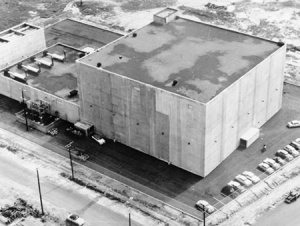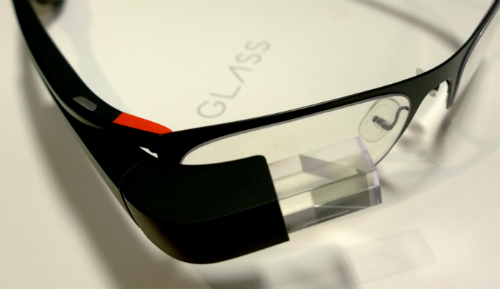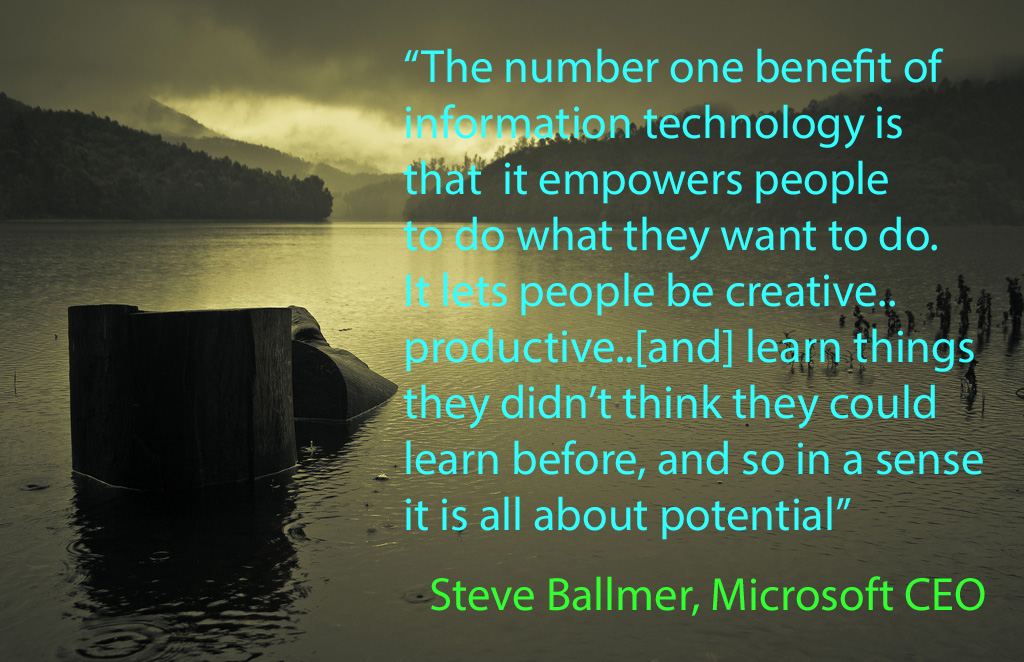How have computers evolved over the decades? What is the trajectory that technology is headed towards moving forward? How much are people an integrated part of technology? As my first technology blog entry, I will today focus on how I foresee the computers of tomorrow to look like.
Introduction
Computer technology has continued to evolve through the many generations starting in the mid-1900s, and it is impossible to foresee a day when computers are no longer something that humans use for information. Most of what we humans do today is connected in some way with computer technology, whether it is using GPS in a car or picking up a phone to call/text a friend.
In the near past, early computers were so massive that entire warehouses were built just to house a single computer, which could process mostly text and some simple calculations. Harddrives, which were connected to those processors (CPUs) through heavy metal coils, for data storage took up entire rooms and weighted tons.
One of them was IBM’s SAGE, which was a radar system used from 1963 to 1984 to track Soviet ICBM (Inter-Continental Ballistic Missiles) during the height of the Cold War.
SAGE consisted of 20 or so Direction Centers, each of which was a windowless, one-acre-large concrete cube (see below). Inside each DC were two CPUs, each one measuring 7,500 sq ft and consisting of 60,000 vacuum tubes, 175,000 diodes, 13,000 newfangled transistors, and 256KB of magnetic core RAM, consuming a total of 3MW of power and weighing in at 250 tons. Each CPU — only one operated at a time; the other was kept as a hot spare to minimize downtime — was capable of executing 75,000 instructions per second, which was enough to spit out tons of radar data to 150 CRT consoles. (extremetech.com)
Imagine one CPU taking up 7,500 sq ft and requiring 3 megawatts of power! Remember, CPU is just one part of a computer. This does not even include other hardware, such as the storage harddrive or massive modems to connect to telephone lines. Today, the weakest & slowest cellphones on the market would outshine the SAGE in every way possible just 40 years later. All while consuming a few watts of power & weighing 5 ounces as opposed to enough energy to power a nuclear powerplant & weighing as much as about 65 adult elephants (250 tons).
The latest evolution in computers has been ubiquitous computing, such as smartphones, that allow it to be used for every situation and wide range of computer applications in one single piece of hardware compressed into light five-ounce casing that can be used at home or on the go. The range of applications also have the versatility to do almost as much as any single personal computer (PC).
Of course, smartphones will never replace PCs, but there is a future that will allow something equivalent to PCs to be fully portable in a pocket thanks to Moore’s Law. As any technologist would know, Moore’s law simply states that transistors in hardware double every 2 years (expected to slow down soon, if it has not already begun). This allows processors/other hardware to essentially shrink as more and more transistors can be fit in same area.
The shrinking will continue as technology improves exponentially. The next step in computer evolution has to allow portable computers to be interactive & usable while seamlessly integrated into our worlds. That is already in progress with the Google glasses. Google glasses are portable companions with on-board dual-core processor, 2 gigabytes of ram, 16 gigs storage, 720p camera, wi-fi (wikipedia). These specifications are as powerful as PCs just a decade ago .
Considering that Google Glass technology is still in their infancy, I want to look at a future where the type of technology that we see in Google glasses enters the prime performance-wise.
Nano Computers of Tomorrow
Imagine a near future world. Imagine walking down the street where interactive computers are accessed virtually simply by punching keys on a virtual keyboard hanging out in front of you with a virtual screen directly above it.
It could be run wirelessly from a small nano-computer using a single 8-core processor in your pocket running at speeds exceeding 4 GHz on a 5 terabyte solid-state harddrive (no moving parts). The physical blueprint of the actual computer may be smaller than the smartphones of today with perhaps a small high-tech projector that can project a virtual screen onto the wall or some other medium. Perhaps the projector may not be necessary at all as the virtual screen can be run directly onto your glasses after being wirelessly connected through Bluetooth to the nano-computer in your pocket.
Merely speaking to it can allow you to access menus and type papers into a virtual text document without having to raise a single finger. There is already software out there today that can do voice-recognition fairly well (i.e. Nuance Dragon). Of course, there is big room for improvement as grammar is difficult to translate directly from spoken language. Talking out an idea is usually much more informal than actually writing about it; arguably you do not speak the same as you write.
Today, a college student may be forced to physically sit in front of their computer monitor for hours typing their paper or to run a graphics intensive program like a new videogame. In the future, the student could be walking down the street with a grocery bag on one hand and some class notes in the other while speaking to type their paper for their class or chatting with a classmate. After reaching home, they may decide to recline on a sofa in front of a wall and play some videogames projected directly onto the wall by simply wirelessly connecting a mouse and keyboard to it or a controller/joystick to their nano-computer.
Everything could also be ubiquitous (computers all around us) & fully centralized (one small personal computer for everything) at the same time, more so than even today’s smartphones or laptops. Applications with different capabilities and vastly different operating system are currently spread too thin across different technologies. Smartphones are the closest thing we have to being fully ubiquitous and centralized, but there are limitations in central processing power and especially graphics processing power that limit them from being used for extensive gaming and processing calculations on same level as today’s personal computers.
The power of a desktop, the mobility of a laptop, and the versatility of a smartphone all packed into one single package. Perhaps my expectations are too high, but that is the world that I see directly around the corner (I will blog in future about something called Raspberry Pi, which could be the very early stage of this micro computer centralization idea in progress).
Beyond Tomorrow
So we started off looking at the world of computing technology starting with one of the earliest computers, namely the SAGE. We looked at the world of near tomorrow that is very much within our grasps. What is beyond that for computer technology? For that, I turn to some quantum physics.
As most technologists know, ASCII binary code (lowest level code that every instruction is made up of called bits) is composed of 0’s and 1’s. With bits, everything must be 0 OR 1 at every single moment in time. That is essentially becoming a limitation as transistors can be shrunk less and less.
So you might wonder what can science/engineering do to build upon that limitation. Quantum physics is a field of physics that deals in tiny subatomic particles such as electrons, photons, quarks, protons, etc. The world of tiny particles acts much differently than the world of much larger atoms & molecules our experiences are mainly limited to. Quantum physics calls their counterpart to bits ‘qubits’. While bits can only be 0 OR 1, qubits also have a third state where they can become 0 AND 1 at the same time.
When I first heard of a state where you are two different bits at the same time, it blew my mind. It is due to something called superposition, which is explained using the famous “Schrodinger’s cat” thought experiment by Austrian physicist Schrodinger. Essentially, if you put a cat in a box and decide to look at the box sometime later. You know the starving cat in there is alive OR dead, but you did not open the box yet. Until you open it to look, you would have to assume the cat is alive and dead at the same time.
“If you put the cat in the box, and if there’s no way of saying what the cat is doing, you have to treat it as if it’s doing all of the possible things—being living and dead—at the same time,” explains Eric Martell, an associate professor of physics and astronomy at Millikin University. “If you try to make predictions and you assume you know the status of the cat, you’re [probably] going to be wrong. If, on the other hand, you assume it’s in a combination of all of the possible states that it can be, you’ll be correct.” (NationalGeographic, 2013)
Remember, it is just a thought experiment looking at the logic of superposition. Nobody sat there putting cats in boxes and starving them to see what happens haha. There is also more to the experiment, but I will not get into it all here.
Anyways, with a third state in the mix, many more calculations can be done much faster in same area as current two-state Silicon chips. Significantly more data could also be stored in same area. This can all, in turn, shrink computers much more while being able to do much more.
Essentially, the impact of computing technology available today to humanity and the near future in Silicon world is nothing compared to the potential of quantum computers.
The most advanced quantum computers have not gone beyond manipulating more than 16 qubits, meaning that they are a far cry from practical application. However, the potential remains that quantum computers one day could perform, quickly and easily, calculations that are incredibly time-consuming on conventional computers… But quantum computing is still in its early stages of development, and many computer scientists believe the technology needed to create a practical quantum computer is years away. Quantum computers must have at least several dozen qubits to be able to solve real-world problems, and thus serve as a viable computing method. (HowStuffWorks)
Clearly there is much research and progress to be made before we enter the age of quantum computers, but it is something that will change the dynamics of humanity and raise the roof on all other technologies as well.
Conclusion
Technology must never define who we are as a species, but it must be a PART of who we are. Not a day goes by that we do not interact with some sort of technology. Even the cavemen innovated & used man-made technology like fire pits and stone tools, and chimps also know how to create basic stick tools to fish out ants from ant colonies. Whether we like it or not, we are meant to innovate ideas, thoughts, technology, and to ultimately progress as a species.
At the end of the day, I believe that computers must be better integrated to work with us as much as we work with them. For now, ubiquitous computing lies in our ideas, books, movies and videogames, but there is no doubt that it is our future.
In the process, we must continuously widen our horizons, map out our destiny, and expand the boundaries of potential that we humans are capable of.
Sources:
IBM SAGE details: http://www.extremetech.com/computing/151980-inside-ibms-67-billion-sage-the-largest-computer-ever-built
Google glasses specifications: http://en.wikipedia.org/wiki/Google_Glass#Technical_specifications
Schrodinger’s cat: http://news.nationalgeographic.com/news/2013/08/130812-physics-schrodinger-erwin-google-doodle-cat-paradox-science/
Quantum Computers: http://computer.howstuffworks.com/quantum-computer1.htm
- My Favorite Books - February 7, 2024
- Review of Carl Sagan’s The Demon-Haunted World - January 31, 2024
- The 75 Greatest Films of All Time - December 22, 2023







